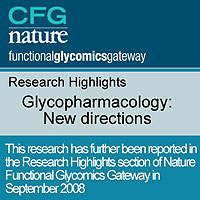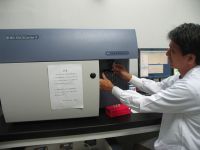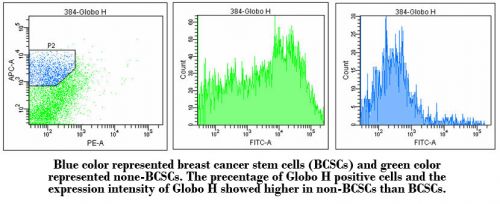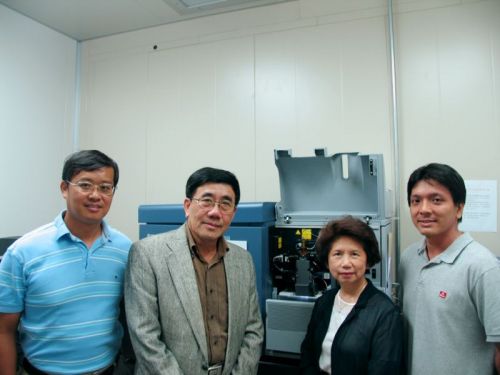 Frustrations in finding effective cures for cancer have led researchers looking into the cancer stem cells (CSCs) in recent years. CSCs possess the capability of stem cells to multiply and differentiate into their progenitors, display resistance to chemotherapy and radiation therapy, and could be the root cause for relapse and metastasis of cancerous tumors. Since the discovery of breast cancer stem cells by Dr. Michael Clarke (now at Stanford University) in 2003, scientists have been actively searching for new targets on the stem cells for development of new drugs to treat or cure breast cancer. Now, under the direction of Associate Director, Alice Yu, and President Chi-Huey Wong, researchers at the Genomics Research Center (GRC) of Academia Sinica have discovered that the hexasaccharide Globo H and its precursor Gb5 are perhaps the targets of therapy for breast cancer. The results have been published in Online Early Edition of PNAS, Proceedings of the National Academy of Sciences of the United States of America ) lately.
Frustrations in finding effective cures for cancer have led researchers looking into the cancer stem cells (CSCs) in recent years. CSCs possess the capability of stem cells to multiply and differentiate into their progenitors, display resistance to chemotherapy and radiation therapy, and could be the root cause for relapse and metastasis of cancerous tumors. Since the discovery of breast cancer stem cells by Dr. Michael Clarke (now at Stanford University) in 2003, scientists have been actively searching for new targets on the stem cells for development of new drugs to treat or cure breast cancer. Now, under the direction of Associate Director, Alice Yu, and President Chi-Huey Wong, researchers at the Genomics Research Center (GRC) of Academia Sinica have discovered that the hexasaccharide Globo H and its precursor Gb5 are perhaps the targets of therapy for breast cancer. The results have been published in Online Early Edition of PNAS, Proceedings of the National Academy of Sciences of the United States of America ) lately.
“Globo H” is overexpressed in many epithelial cancers and has been used as a vehicle in developing an immunotherapeutic vaccine for breast cancer which has successfully passed the phase I clinical trials in the States (Note). Globo H was also used in the study of biochips for developing cancer diagnostic tools in GRC. The team determined to do a series of quests to see if the breast cancer vaccine can target the cancer stem cells as well.
Led by Dr. Alice Yu, in collaboration with the Director of Stem Cell Group, Dr. John Yu, the team decided to test Globo H as well as Gb5 for their presence in breast cancer stem cells, and the possible correlation to the breast cancer vaccine . Gb5 is a pentasaccharide precursor of Globo H, also known as “SSEA”. Up till now, Gb5 has been known as a marker for human embryonic stem cells that can be spotted only in stem cell labs during the embryonic developing stages.
|
The innovative approach turned out to be quite a success. By using flow cytometry to examine tumor tissues obtained from 53 breast cancer patients from the Tri-Service General Hospital, final results showed that both Globo H and Gb5 can be found on the breast cancer stem cells! Of all tested, Globo H is 61% positive on regular breast cancer cells and 20% positive on breast cancer stem cells; Gb5 shows a total of 77.5% positive on regular breast cancer cells and 62.5% on breast cancer stem cells.
The team is thrilled by the result, which suggests that the Globo H vaccine will not only target the cancer cells, but also the cancer stem cells for an one for all raid. Researchers are particular excited about the discovery of Gb5 in cancer cells as well, since the result shows that Gb5 is even more easily spotted on both regular breast cancer cells and stem cells, indicating that Gb5 may be another candidate for cancer therapeutics study.
The group has also demonstrated that both fucosyltransfease 1 (FUT1) and 2 (FUT2) were involved in the biosynthesis of Globo H in breast cancer. In a further animal model study, by transplanting human breast cancers into lab mice, they showed a much lower expression of FUT2 in cancer stem cells and explains why the expression of Globo H on breast CSCs is lower.
 In the animal study, the researchers have also proved that Globo H vaccine can induce antibodies against both Globo H and Gb5. Furthermore, by addingα-galatosylceramide as an adjuvant with Globo H vaccine, the resulting antibodies against Globo H and Gb5 increased significantly. “All these wonderful findings show a promising future for a resolution that can actually cure breast cancers, and the possibility to design a more powerful next generation breast cancer vaccine”, said Dr. Alice Yu.
In the animal study, the researchers have also proved that Globo H vaccine can induce antibodies against both Globo H and Gb5. Furthermore, by addingα-galatosylceramide as an adjuvant with Globo H vaccine, the resulting antibodies against Globo H and Gb5 increased significantly. “All these wonderful findings show a promising future for a resolution that can actually cure breast cancers, and the possibility to design a more powerful next generation breast cancer vaccine”, said Dr. Alice Yu.
On the other hand, Globo H and its analogs were prepared as arrays on chips to examine the blood serum of cancer patients and non-patients, based on the fact that breast cancer patients have a much higher globo H antibodies as opposed to healthy people. As a result, the study showed that a trace of the anti-globo H antibodies at the attomole level in the serum can be detected by the sugar chips. “This can be used hand in hand with the clinical trials project to screen patients for vaccine trials, and to monitor the immune responses.” commented Dr. CH Wong.
Collaborators of breast cancer stem cells research include Dr. John Yu of GRC Stem Cell Lab, Dr. Jyh-Cherng Yu of Tri-Service General Hospital, and postdoctoral researchers, Wen-Wei Chang, Chien-Hsin Lee and Jung-Tung Hung. The sugar chip research was co-directed by Dr. Chung Yi Wu, in collaboration with Dr. Alice L. Yu and Dr. Juh-Cherng Yu; the first author is Ms. Wang, Cheng-Chi, a graduate student.
|
The Globo H breast cancer vaccine, prepared by Dr. Wong’s one-pot synthesis, will start a phase II human trial by a pharmaceutical company in Taiwan.
Expression of Globo H and SSEA3 in breast cancer stem cells and the involvement of fucosyl transferases 1 and 2 in Globo H synthesis. [Abstract]
Glycan microarray of Globo H and related structures for quantitative analysis of breast cancer. [Abstract]

